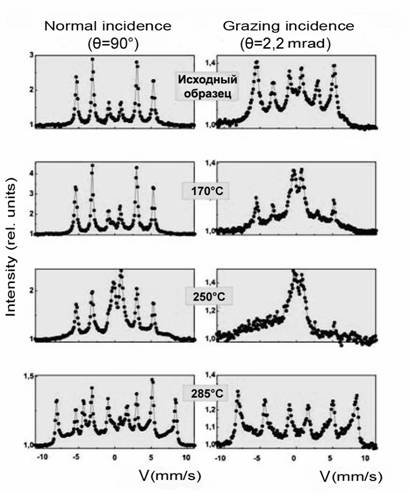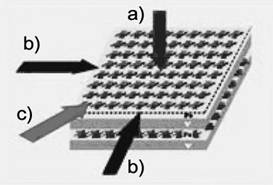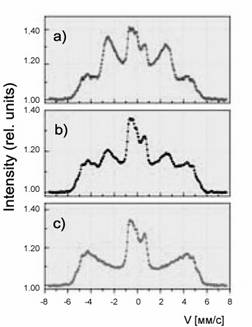|

Spectrometer SM 1101TER is designed to examine, with a record-breaking depth resolution, physical-chemical condition of surfaces, interfaces and multilayer synthetic structures containing Moessbauer isotopes as basic or impurity elements. Spectrometer SM 1101TER realizes the potentialities of a new method of gamma-resonance, glide Moessbauer spectrometry, that combines the potentialities of two physical effects: Moessbauer effect and the effect of total external reflection of resonance radiation. This method was developed at IAI RAS (1993-1995). The glide Moessbauer spectrometry method is based on the interaction between resonance radiation and matter in the region of grazing incidence of radiation on the surface of matter under study. The result of this interaction is a cascade of radiations of the following types: 1. specularly reflected gamma-rays; 2. gamma-rays scattered from atoms and electrons; 3. conversion and Auger electrons, and 4. secondary X-rays. Moessbauer radiation penetration into the medium depends on the primary radiation angle of incidence. Since the angle of incidence varies in the course of experiment, one can perform the investigation selectively in depth.
Spectrometer 1101TER can be used most effectively in the following areas: fundamental investigation of surface effects in condensed mediums; physics and technology of quantum-electronic elements; X-ray and synchrotron-ray optics. The spectrometer performance is illustrated by the cases of studying corrosion and spin texture.
 Thermostimulated corrosion at temperatures of 150 to 470° Ñ (at film thickness of 20 nm) The spectra illustrate the method surface sensitivity and demonstrate a drastic difference of Moessbauer spectra parameters averaged over the entire film thickness (left part) from parameters of the near-surface layer 3 to 5 nm thick (right part).
Analysis of the spectra shows that, when the radiation is directed diagonally to the sample, the second and fifth lines disappear. This is the evidence of a strong magnetic anisotropy along the diagonal.
The instrument ensures both simultaneous and independent recording of nuclear gamma-resonance spectra of specularly reflected and secondary radiations in a wide range of incidence angles. Simultaneous detection of all the radiations accompanying the primary interaction between the radiation and matter allows one to decrease considerably the time of measurement and improve the experimental data reliability, since all the measurements are acquired in a single experiment from a sample kept under constant conditions. Results of such a comprehensive investigation supplement each other and provide more complete data on both the structure of ultra-thin layers of the surface under study and peculiar features of the radiation-matter interaction in the grazing mode. Commercially produced Moessbauer spectrometers cannot realize the potentialities of the grazing-incidence Moessbauer spectroscopy, since their optical schemes are based on one physical phenomenon only, namely, Moessbauer effect. At the same time, the SM 1101TER Moessbauer spectrometer allows one to use also the following conventional schemes of Moessbauer gamma optics : 1) transmission; 2) emission; 3) back scattering; 4) Bragg and Rayleigh scattering. Experimental data obtained by the spectrometer are, mostly, of a unique character. In addition, those results allows one to supplement the surface state data provided by other methods of analysis, such as ESCA and Auger spectroscopy, with data on microphase, structural and magnetic states.
The technique and engineering solutions are defended by the Certificates of Authorship A.C. No. ¹ 1124714, 1721485 and 1725103.
Institute of Analytic Instrumentation RAS.
The mandatory delivery set comprises software for mathematical processing of measurements. |
||||||||||||||||||||||||||||||||||
  |
Moessbauer spectrometer ÑÌ 1101TER |
190103 Russia,St.Petersburg, Rizhsky pr., 26 ; t.: (812) 2518600, fax: (812) 2517038, mail: iap@ianin.spb.su |


